|
|

Product Number: ACS-7000RMK=
This document provides instructions for installing a Cisco 7513 or Cisco 7576 chassis in a 19-inch rack and a telco rack. For complete system installation and startup procedures, refer to the Cisco 7500 Series Installation and Configuration Guide.
This publication includes the following sections:
 | Caution Before installing the chassis in a rack or wiring closet, read the "Safety Warnings" section to familiarize yourself with the proper site and environmental conditions. Failure to read and follow these guidelines could result in bodily injury or damage to the system chassis or components. The procedure in this document requires two or more people to perform. |
This section describes the types of racks for which this rack-mounting kit is intended, and the mounting configurations that are possible with each type.
The rack-mount kit, Product Number ACS-7000RMK(=), is suitable for mounting the chassis in most 19-inch 2-post, 4-post, or telco-type racks.
The rack must have at least two mounting posts on which to mount the hardware, and the distance between the mounting holes in the two posts must be 18.31 inches ± 0.063 inches according to Electronic Industries Association (EIA) specification -310-C.
Figure 1 shows the three types of equipment racks described in this document:

Following is a summary of the installation procedures required to rack-mount the chassis. This summary is informational and is not intended to replace the actual procedures required to rack-mount the chassis.
1. Verify that all mounting kit hardware is available; refer to the "Mounting Kit Hardware" section.
2. Read the "Rack-Mount Chassis Installation Prerequisites" section.
3. Install the brackets on the rack posts; refer to the "Installing the Brackets" section.
4. Attach the spanner bars between the brackets; refer to the "Attaching the Spanner Bars" section.
5. Attach the chassis ears to the chassis; refer to the "Attaching the Chassis Ears" section.
6. Prepare the chassis for installation; refer to the "Preparing the Chassis and Installing the Chassis in a Rack" section and the "Chassis and Component Weights" section. (This section includes information about the weight of the chassis and its components, and procedures for removing the power supplies, card cage assembly, processor modules, and blower module.)
7. Install the chassis in the rack; refer to the "Moving the Chassis into the Rack" section.
The mounting kit comprises two brackets, two chassis ears (each holds two captive grommets), and fasteners (screws). On each bracket, the inner side has a turned ledge at the bottom to support the chassis, and non-conductive material to provide electrical isolation between the chassis and the rack. At the front of each bracket is a flange with five mounting holes at the top and three at the bottom.
Table 1 lists the parts that are included in the rack-mount kit. To verify that you received all the parts listed, see Table 1 and Figure 2. If any parts are missing, contact a service representative for assistance. (Refer to the "Cisco Connection Online" section.)
| Quantity | Part Description | Received |
|---|---|---|
2 | Mounting brackets (left and right are identical), each with an attached spanner bar |
|
2 | Chassis ears with captive grommets (left and right ears are identical) |
|
4 | M4 x 10-mm LG Phillips flat-head screws |
|
12 | 10-32 x LG Phillips pan-head screws with integral square cone washers |
|
Each of the two brackets mounts to a rack post with four 10-32 x 5/8-inch, Phillips pan-head screws, which are provided. The front of each bracket attaches to the front of the rack post, and the remainder of the bracket cantilevers off the post. A ledge at the bottom of each bracket provides a shelf for the bottom edges of the chassis.
A spanner bar on each bracket hooks into the opposite bracket to maintain an exact distance between the two brackets at both of the ends attached to the rack posts. The spanner bars prevent the two brackets from separating. See the "Attaching the Spanner Bars" section.
Figure 2 shows the components in the rack-mount kit.
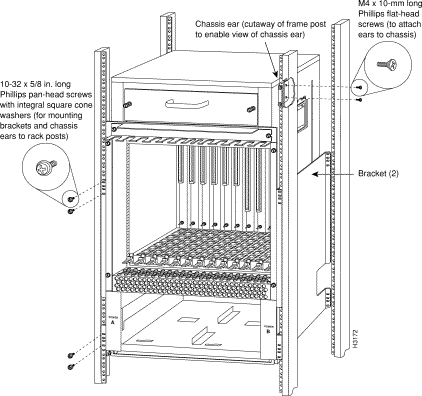
One chassis ear attaches to each side of the chassis with two M4 x 10-mm, Phillips flat-head screws. When the chassis is in the rack, the mounting strips on the chassis ears attach to the rack-mounting posts with four 10-32 x 5/8-inch, Phillips pan-head screws (two for each ear).
The ledges at the bottom of the brackets support the weight of the chassis. The ears are not weight-bearing fixtures, but prevent the chassis from sliding out of the rack horizontally.
In telco-type installations, you can install the chassis so that the ends of the chassis are approximately centered on two posts. The chassis ears can be turned around to prevent the chassis from sliding horizontally. Figure 3 shows a typical center-mount installation.
 | Caution To maintain a safe center of gravity in telco-type installations, the front and rear of the chassis are approximately centered on the mounting posts. |
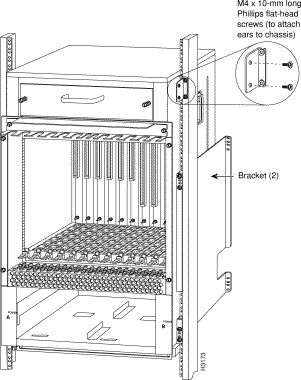
In a 2-post, 4-post, or telco-type installation, you can flush-mount the chassis so that the end of the chassis is flush with the rack posts. Figure 4 shows a typical flush-mount installation.

Before you begin this installation, review the safety guidelines in this section to avoid injuring yourself or damaging the equipment. This section also provides descriptions of the tools and parts you need to perform this installation, and guidelines for planning the rack location so that you can access the system components when necessary and maintain trouble-free operation.
If you are mounting a chassis that is already installed, you will need to disconnect all power and interface cables from the back of the chassis. Be sure to label the cables to avoid confusion when you reconnect them to the interface ports. The port and slot configuration worksheet (in the "Port and Slot Configuration Worksheet" section) can help you reconnect the cables to the correct ports. Make a copy of the worksheet and complete it as you disconnect cables from the chassis.
Safety warnings appear throughout this publication in procedures that, if performed incorrectly, may harm you. A warning symbol precedes each warning statement.
| Warning This warning symbol means danger. You are in a situation that could cause bodily injury. Before you work on any equipment, be aware of the hazards involved with electrical circuitry and be familiar with standard practices for preventing accidents. To see translations of the warnings that appear in this publication, refer to the Regulatory Compliance and Safety Information document that accompanied this device. |
Waarschuwing Dit waarschuwingssymbool betekent gevaar. U verkeert in een situatie die lichamelijk letsel kan veroorzaken. Voordat u aan enige apparatuur gaat werken, dient u zich bewust te zijn van de bij elektrische schakelingen betrokken risico's en dient u op de hoogte te zijn van standaard maatregelen om ongelukken te voorkomen. Voor vertalingen van de waarschuwingen die in deze publicatie verschijnen, kunt u het document Regulatory Compliance and Safety Information (Informatie over naleving van veiligheids- en andere voorschriften) raadplegen dat bij dit toestel is ingesloten.
Varoitus Tämä varoitusmerkki merkitsee vaaraa. Olet tilanteessa, joka voi johtaa ruumiinvammaan. Ennen kuin työskentelet minkään laitteiston parissa, ota selvää sähkökytkentöihin liittyvistä vaaroista ja tavanomaisista onnettomuuksien ehkäisykeinoista. Tässä julkaisussa esiintyvien varoitusten käännökset löydät laitteen mukana olevasta Regulatory Compliance and Safety Information -kirjasesta (määräysten noudattaminen ja tietoa turvallisuudesta).
Attention Ce symbole d'avertissement indique un danger. Vous vous trouvez dans une situation pouvant causer des blessures ou des dommages corporels. Avant de travailler sur un équipement, soyez conscient des dangers posés par les circuits électriques et familiarisez-vous avec les procédures couramment utilisées pour éviter les accidents. Pour prendre connaissance des traductions d'avertissements figurant dans cette publication, consultez le document Regulatory Compliance and Safety Information (Conformité aux règlements et consignes de sécurité) qui accompagne cet appareil.
Warnung Dieses Warnsymbol bedeutet Gefahr. Sie befinden sich in einer Situation, die zu einer Körperverletzung führen könnte. Bevor Sie mit der Arbeit an irgendeinem Gerät beginnen, seien Sie sich der mit elektrischen Stromkreisen verbundenen Gefahren und der Standardpraktiken zur Vermeidung von Unfällen bewußt. Übersetzungen der in dieser Veröffentlichung enthaltenen Warnhinweise finden Sie im Dokument Regulatory Compliance and Safety Information (Informationen zu behördlichen Vorschriften und Sicherheit), das zusammen mit diesem Gerät geliefert wurde.
Avvertenza Questo simbolo di avvertenza indica un pericolo. La situazione potrebbe causare infortuni alle persone. Prima di lavorare su qualsiasi apparecchiatura, occorre conoscere i pericoli relativi ai circuiti elettrici ed essere al corrente delle pratiche standard per la prevenzione di incidenti. La traduzione delle avvertenze riportate in questa pubblicazione si trova nel documento Regulatory Compliance and Safety Information (Conformità alle norme e informazioni sulla sicurezza) che accompagna questo dispositivo.
Advarsel Dette varselsymbolet betyr fare. Du befinner deg i en situasjon som kan føre til personskade. Før du utfører arbeid på utstyr, må du vare oppmerksom på de faremomentene som elektriske kretser innebærer, samt gjøre deg kjent med vanlig praksis når det gjelder å unngå ulykker. Hvis du vil se oversettelser av de advarslene som finnes i denne publikasjonen, kan du se i dokumentet Regulatory Compliance and Safety Information (Overholdelse av forskrifter og sikkerhetsinformasjon) som ble levert med denne enheten.
Aviso Este símbolo de aviso indica perigo. Encontra-se numa situação que lhe poderá causar danos físicos. Antes de começar a trabalhar com qualquer equipamento, familiarize-se com os perigos relacionados com circuitos eléctricos, e com quaisquer práticas comuns que possam prevenir possíveis acidentes. Para ver as traduções dos avisos que constam desta publicação, consulte o documento Regulatory Compliance and Safety Information (Informação de Segurança e Disposições Reguladoras) que acompanha este dispositivo.
¡Advertencia! Este símbolo de aviso significa peligro. Existe riesgo para su integridad física. Antes de manipular cualquier equipo, considerar los riesgos que entraña la corriente eléctrica y familiarizarse con los procedimientos estándar de prevención de accidentes. Para ver una traducción de las advertencias que aparecen en esta publicación, consultar el documento titulado Regulatory Compliance and Safety Information (Información sobre seguridad y conformidad con las disposiciones reglamentarias) que se acompaña con este dispositivo.
Varning! Denna varningssymbol signalerar fara. Du befinner dig i en situation som kan leda till personskada. Innan du utför arbete på någon utrustning måste du vara medveten om farorna med elkretsar och känna till vanligt förfarande för att förebygga skador. Se förklaringar av de varningar som förkommer i denna publikation i dokumentet Regulatory Compliance and Safety Information (Efterrättelse av föreskrifter och säkerhetsinformation), vilket medföljer denna anordning.
Review the following guidelines to help ensure your safety and protect the equipment from damage during the installation.
A Cisco 7513 or Cisco 7576 chassis weighs 50 pounds (22.7 kilograms [kg]) when empty (with no interface processors, card cage, blower module, or power supplies installed) and 160 pounds
(72.58 kg) with two power supplies and 13 processor modules installed. The chassis is not intended to be moved frequently.
 | Warning To prevent tipping the chassis when moving it, do not use a ramp inclined at more than 10 degrees. |
Before you install the router, ensure that your site is properly prepared, so you can avoid having to move the chassis later to accommodate power sources and network connections.
Whenever you lift the chassis or any heavy object, follow these guidelines:
 | Warning The chassis weighs approximately 75 pounds with just the blower module installed. To prevent injury, have someone help you lift the chassis, as shown in Figure 5. |

 | Caution To prevent damage to the air intake vent below the card cage, do not lift the chassis by grasping the handle with one hand and the bottom of the card cage with the other, as shown in Figure 6. The air intake vent is not designed to support the weight of the chassis. |

Follow these basic guidelines when working with any electrical equipment:
 | Warning To prevent injury, always disconnect all cables before moving or working on the chassis. When the chassis is disconnected from all power sources, telephone wiring can still deliver potentially lethal electrical surges. |
When you replace the power supplies, remember to engage all of the safety features on each power supply. The power supplies feature the following three safety interlock features:
For a complete description of the power supplies, refer to the Cisco 7500 Series Installation and Configuration Guide.
When working with any electrical equipment, the following guidelines will help to ensure your safety and protect the equipment. This list does not include all potentially hazardous situations, so be alert.
The rack-mount kit is suitable for mounting the Cisco 7513 and Cisco 7576 in most 19-inch 2-post, 4-post, or telco-type racks that conform to the EIA-310-C specification. The brackets, which support the chassis, cantilever off two rack posts. You can then mount the chassis with either end approximately flush with the two rack posts or, in telco-type installations, you can center-mount the chassis.
Before proceeding, review the guidelines in this section. Ensure that you have planned your installation carefully. Avoid hazards such as top-heavy or unbalanced racks, or cables or equipment that obstruct traffic paths and access to equipment.
Figure 7 shows the chassis footprint and outer dimensions, and the clearance required to remove or install power supplies, processor modules, and the blower module.
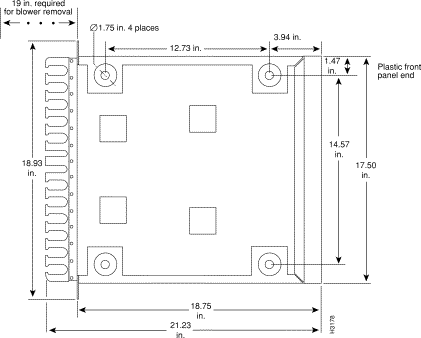
Planning a proper location for the router and the layout of your equipment rack is essential for successful system operation. Equipment placed too close together or inadequately ventilated can cause overtemperature conditions inside the chassis. In the Cisco 7513 and Cisco 7576, cooling air is drawn in through the rear of the chassis, and exhaust air is forced out the front through the panel vent.
The following guidelines are recommended to ensure a sufficient flow of cooling air to the chassis:
For complete site requirements and recommendations, refer to the Cisco 7500 Series Installation and Configuration Guide.
When installing one chassis in any rack that is not secured to the floor or overhead structure, place the chassis in the lower half of the rack. A fully configured Cisco 7513 or Cisco 7576 weighs 160 lbs (72.58 kg), and a shift in the weight distribution (during the installation or later) can cause the rack to fall.
 | Caution To maintain a low center of gravity in a rack with a single Cisco 7513 or Cisco 7576 chassis, the chassis bottom should be no higher than 20 inches above the floor. |
Also, when installing the chassis in telco-type racks, ensure that the rack is secured to the floor or otherwise stabilized. Center-mount the chassis if possible (and practical for your installation). Doing so places the center of gravity closest to the center of the mounting posts. Figure 8 shows the center of gravity for both center-mounted and flush-mounted installations. (The center of gravity will shift somewhat depending on which end of the chassis is positioned at the front of the rack.)
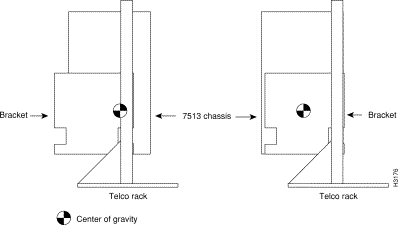
To help maintain trouble-free operation, consider the following precautions when planning your rack installation:
This section lists the tools you will need to complete this installation and the parts that are shipped as part of the rack-mount kit. Ensure that you have all the tools and parts required so that you can complete the installation without interruption.
You will need the following tools to install the mounting hardware and chassis in the rack:
You also need the following tools to replace the power supplies after mounting the chassis:
Before beginning the power supply installation, check the captive installation screws on all power supplies to determine which tools you will need.
The following sections describe the procedures for mounting the chassis in a 19-inch equipment rack with two or four mounting posts or a telco-type rack.
Before proceeding, review the guidelines and recommendations in the "Rack-Mount Chassis Installation Prerequisites" section to protect your safety, to maintain sufficient clearance around the rack during and after the installation, and to ensure proper airflow through the chassis after the installation.
 | Warning To avoid potentially serious bodily injury, this procedure requires two or more people to perform. |
Some equipment racks provide a power strip along the length of one of the rear mounting strips. If your rack has this feature, we recommend that you fasten the brackets and install the interface processor end of the chassis at the opposite side of the rack.
The two brackets provided in the rack-mounting kit are identical. The inner side of each bracket has a ledge at the bottom to support the undersides of the chassis, and shielding to provide electrical isolation between the chassis and the rack. A flange on the front of each bracket provides five mounting holes at the top, and three at the bottom. Mount the bracket with the flange in front of the rack post, and with the inner (shielded) side facing the center of the rack. The ledge should be at the bottom of the bracket. (See Figure 9.) To maintain a low center of gravity, mount the brackets in the rack at the lowest point possible.
 | Caution To maintain a low center of gravity in a rack with a single Cisco 7513 or Cisco 7576 chassis, the chassis bottom should be no higher than 20 inches above the floor. |
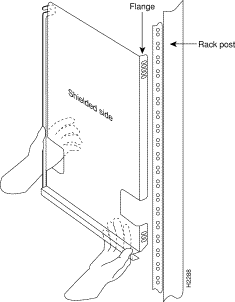
The cutouts in the brackets are to accommodate the ear brackets that fasten the Cisco 7000 chassis to the rack. The chassis ears mount farther up on the Cisco 7513 or Cisco 7576 chassis.
To mount each bracket to a rack post, follow these steps:
Step 1 Measure the space between the inner edges of the left front and right front equipment rack-mounting posts to ensure that it is at least 17.72 inches. The chassis is 17.5 inches wide and must fit between the mounting posts.
Step 2 Measure the distance between the holes in the mounting posts to ensure that it is 18.31 inches ± 0.063 inches. Make several measurements down the length of the posts to ensure they are parallel.
Step 3 Holding the first bracket in the position shown in Figure 10, place the bracket on the inner side of the rack post, with the flanged front edge of the bracket in front of the rack post. To maintain a low center of gravity, mount the brackets in the rack at the lowest point possible.

Step 4 Slide the bracket up and down along the mounting post to align the mounting holes in the bracket with those in the rack post.
Step 5 While supporting the bracket with one hand, use the other hand to insert a 10-32 x 5/8-inch, Phillips pan-head screw through the bottom mounting hole on the front of the bracket and into the rack post. (See Figure 10.)
Step 6 Insert and finger tighten a second screw just above the first screw.
Step 7 Secure the top of the bracket to the rack with two more pan-head screws. Finger tighten these screws. Finger tighten the pan-head screws, but do not completely tighten them because you will need to adjust them when you attach the spanner bars later.
Step 8 Repeat steps 3 through 7 for the remaining bracket. Use a level or tape measure to ensure that the two brackets are level in the rack.
 | Caution To ensure adequate space between the brackets, and to ensure the chassis stays in the rack, push the brackets as far apart as possible before tightening the screws that secure them. |
Step 9 Measure the horizontal distance between the left and right brackets. The distance must be greater than 17.5 inches for the chassis to clear the brackets; adjust the rack's mounting strips as required.
To position and secure the spanner bars, proceed to the next section.
The spanner bar on each bracket hooks into the opposite bracket to maintain a fixed spacing between the two brackets. The spanner bars prevent the brackets from separating or drifting apart, particularly at the bracket ends that are not secured to the rack.
To secure the spanner bars, follow these steps:
Step 1 Loosen the 10-32 x 5/8-inch, Phillips pan-head screw in the end of the ledge of the right-side bracket. (See Figure 11b.) This screw is the anchor for the spanner bar.
Step 2 Remove the tape that secures the spanner bar on the left bracket, and swing the bar down (see Figure 11a) over the anchor screw on the opposite bracket. (See Figure 11b.)
Step 3 If the spanner bar does not reach the opposite bracket, loosen the pan-head screws to allow more play between the brackets, and adjust the brackets as required.
Step 4 When the first spanner bar is secured, go around to the other side of the rack and repeat steps 1 through 3 to fasten the remaining spanner bar to its anchor screw. (See Figure 11c.)
 | Caution To ensure adequate space between the brackets and a proper chassis fit, push the brackets as far apart as possible before tightening the screws that secure them and the spanner bars. |

Step 5 When both spanner bars are in place, use a number 2 Phillips screwdriver to tighten the six pan-head screws that secure the brackets to the rack-mounting posts and the two anchor screws that secure the spanner bars.
When tightening the pan-head screws on a bracket, push the bracket outward, away from the center of the rack, to ensure that the brackets remain at least 17.5 inches apart (otherwise the chassis will not fit between the brackets).
This completes the bracket installation.
To install the ears on the chassis, proceed to the next section.
The ears attach directly to the chassis with four M4 x 10-mm, flat-head screws (two on each side).
Attach the ears to the chassis before you slide the chassis onto the brackets and into the rack. After you slide the chassis into the rack, insert a 10-32 x 5/8-inch pan-head screw through each of the captive grommets on the ears and through the rack-mounting strips.
The ears do not bear the weight of the chassis, but prevent it from walking, or sliding horizontally out of the rack.
In Figure 12, the cutaway insets on the right show how the ears attach to the chassis for center mounting and flush mounting.
See Figure 3, for a typical center-mount installation and Figure 4, for a typical flush-mount installation.
In some telco-type racks, it is more practical to center-mount the chassis. To do so, flip the ears around so that the mounting strips are near the center of the side of the chassis. In Figure 12, the upper insert on the right shows how the ears attach to the chassis for center mounting.
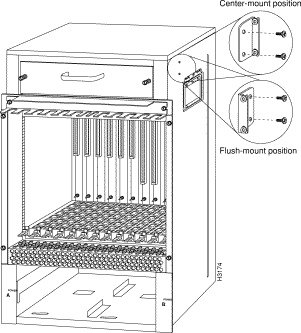
To install the ears on the chassis, follow these steps:
Step 1 While referring to Figure 12, position the ears on the chassis as follows:
Step 2 Use two M4 x 10-mm, flat-head Phillips screws to secure each ear to the chassis. Tighten the screws, but do not overtighten them.
Proceed to the next section to install the chassis in the rack.
Two people are required to lift the chassis and complete this part of the installation.
You will need to lift the chassis and slide it into the rack and onto the ledges provided by the brackets. After you push the chassis back into the rack, you will attach the ears to the rack-mounting strips to prevent the chassis from sliding forward or backward out of the rack.
Before moving the chassis, we recommend that you disconnect all power and interface cables and that you remove both power supplies and all processor modules.
Removing the card cage assembly and blower module is recommended before installing the chassis, but is not required; their combined weight is approximately 25 pounds.
If you choose not to remove the power supplies, processor modules, blower module, and card cage assembly, consider the following:
Before you remove the card cage assembly, you must remove the power supplies.
On AC-input and DC-input power supplies, a power switch with a locking mechanism prevents the power supply from being removed from the chassis when the power supply switch is in the on (|) position. (See Figure 13.) When the switch is on, a metal tab extends into a slot in the chassis. When the switch is off (O), the tab is raised and clears the slot.
For the DC-input power supply, you must provide two nylon cable ties for cable strain relief. Replace the strain relief with new nylon cable ties after you replace the DC-input power supply. In addition to a large slotted screwdriver, you also need a pair of wire cutters for this procedure.
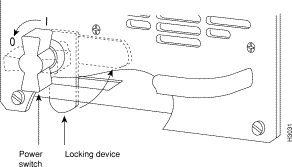
If you have AC-input power supplies, refer to the following sections:
1. Removing AC-Input Power Supplies.
3. Removing the Card Cage Assembly.
4. Moving the Chassis into the Rack.
5. Checking Electrical Isolation
6. Replacing the Blower Module
If you have DC-input power supplies, do the following:
1. Removing DC-Input Power Supplies.
2. Removing the Blower Module.
3. Removing the Card Cage Assembly.
4. Moving the Chassis into the Rack.
5. Checking Electrical Isolation.
6. Replacing the Blower Module
To remove a DC-input power supply, follow these steps:
Step 1 Turn off (O) the system power switch on the power supply you are going to remove.
 | Warning This warning applies only to units equipped with DC input power supplies. Before performing any of the following procedures, ensure that power is removed from the DC circuit. To ensure that all power is off, locate the circuit breaker on the panel board that services the DC circuit, switch the circuit breaker to the off position, and tape the switch handle of the circuit breaker in the off position. |
Step 2 If the power supply is connected to the DC power source, turn off the circuit breaker to which the system is connected and tape the breaker switch in the off position.
 | Warning This unit might have more than one power cord. To reduce the risk of electric shock, disconnect the two power supply cords before servicing the unit. Loosen the screws on the terminal block cover. (See Figure 14.) |
 | Warning This warning applies only to units equipped with DC input power supplies. Wire the DC power supply using the appropriate lugs at the wiring end. The proper wiring sequence is ground to ground, positive to positive (line to L), and negative to negative (neutral to N). Note that the ground wire should always be connected first and disconnected last. |
Step 3 Slide the terminal block cover in the direction of the large arrow in Figure 14.

Step 4 Use the large slotted screwdriver to loosen the captive screw that secures the power supply to the chassis frame. (See Figure 15.)
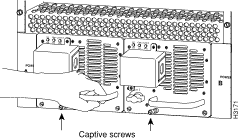
Step 5 Grasp the power supply handle and pull the power supply about halfway out of the bay. Then with your other hand under the power supply, pull it completely out of the bay. (See Figure 16.)
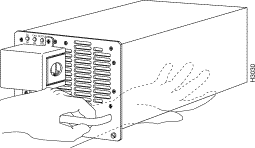
To remove an AC-input power supply, follow these steps:
Step 1 Turn off (O) the system power switch on the power supply you are going to remove.
Step 2 Disconnect the power cable from the power receptacle of the power supply you are removing.
 | Warning This unit might have more than one power cord. To reduce the risk of electric shock, disconnect the two power supply cords before servicing the unit. |
Step 3 Use a large slotted screwdriver to loosen the captive screw that secures the power supply to the chassis frame. (See Figure 17.) Only loosen the captive screw of the power supply you are removing.

Step 4 Grasp the power supply handle and pull the power supply about halfway out of the bay. Then with your other hand under the power supply, pull it completely out of the bay. (See Figure 18.)
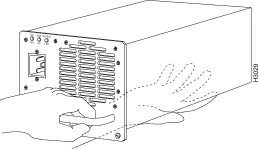
When viewing the chassis from the noninterface processor end, the blower module is located above the card cage (See Figure 19.) Two slotted captive screws hold the blower module in place.
 | Warning It is not necessary to turn off system power before removing the blower module; however, when the power is off and the blower module is removed, high current is exposed on the blower module power connector at the backplane. |
To remove and replace the blower module, follow these steps:
Step 1 Use a flat-blade screwdriver to loosen the captive screws that fasten each end of the blower module to the chassis. (See Figure 19.)
 | Warning Although the system should not be operating when you remove the blower module, it is not necessary to turn off system power before removing the blower module. However, with the system power on and the blower module removed, high current is exposed on the blower module power connector at the backplane; do not insert conductive items into the empty blower module opening. After an operating blower module is removed, the blower impeller blades will continue to spin for approximately two minutes; do not insert anything into the module's vent holes while the impeller is spinning. |
Step 2 Grasp the handle on the front of the module and slowly pull the blower module straight out of the chassis. (See Figure 19.)
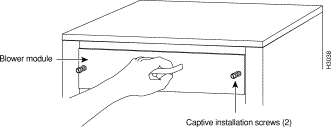
This completes the blower module removal procedure.
The card cage consists of one assembly that includes the card cage and backplane, which can be removed and replaced as required. There are no wires, harnesses, or connectors. The assembly slides into and out of the chassis and attaches to the chassis frame with four slotted, captive screws.
For this procedure, you will need one large flat-blade screwdriver, an antistatic bag for each removed processor module, or several antistatic mats or pieces of antistatic foam.
 | TimeSaver Before you can remove the card cage and backplane assembly, you must remove all processor modules and both power supplies. Plan this procedure so that you can minimize its effects on your system. |
Temporarily place removed processor modules in the collapsible, black cardboard racks that were provided with your packing material, as shown in Figure 20.
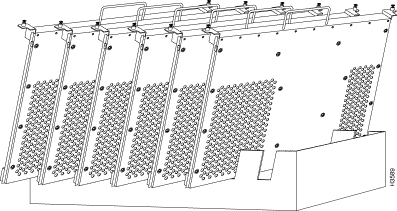
To replace the card cage and backplane assembly, follow these steps:
Step 1 Turn the power switch on each power supply to the off position (O).
Step 2 Disconnect the power cable from each power supply (if attached); then remove each power supply and set it aside. (Refer to the "Removing DC-Input Power Supplies" section or the "Removing AC-Input Power Supplies" section.)
Step 3 Remove all processor modules from the chassis card cage and carefully store them in the black cardboard racks provided with the packaging.
Make a note of the processor module slot and port numbers using the port and slot configuration worksheet in the "Port and Slot Configuration Worksheet" section. Do not stack the processor modules one on top of another. It is possible to remove the card cage from the chassis with the processor modules installed; however, it is not recommended. Thirteen processor modules weigh 32.5 pounds (14.7 kg) and make the card cage assembly difficult to manage.
Step 4 With the processor modules and power supplies removed, loosen the four large captive screws located to the left and right of the card cage opening. (See Figure 21.)
 | Caution Unless the chassis is mounted in a rack, or otherwise anchored, the chassis might move toward you when you pull out the card cage and backplane assembly. To prevent injury, have a second person hold the chassis in place while you pull the card cage and backplane assembly from the chassis in the following step. |
Step 5 With the captive screws loosened, carefully pull the card cage and backplane assembly straight out of the chassis until the entire assembly is clear of the chassis sides. (See Figure 21.) The assembly is not heavy, but might be awkward to handle.
Step 6 When the card cage and backplane assembly is completely free of the chassis, carefully place it on an antistatic mat or foam.
 | Caution The electronic components on the rear of the backplane are completely exposed when the card cage and backplane assembly is removed from the chassis. To prevent damaging these components, place the card cage and backplane assembly on an antistatic mat or foam, and place the assembly in the same orientation as when it is mounted in the chassis. (See Figure 21.) |

Two people are required to lift the chassis and insert it into the rack.
The chassis weighs approximately 75 pounds (34.02 kg) when the power supplies and processor modules are removed. Make sure that your path to the rack is not obstructed.
You will insert the front end of the chassis into the rack, lower it onto the two ledges on the brackets, and then slide the chassis back until the ears meet the rack-mounting posts.
 | Caution To avoid damaging power supplies and interface processors, never attempt to lift the chassis using the handles on the power supplies or the interface processors, or the intake air vent beneath the card cage. These areas are not designed to support the weight of the chassis. Using them to lift or support the chassis can result in severe damage to the equipment and serious bodily injury. |
To install the chassis in the rack, follow these steps:
Step 1 Two people are required to perform this step. With a person positioned at either side of the chassis, grasp the bottom edge of the chassis with one hand near the front and the handle on the side of the chassis with the other.
Step 2 Slowly lift the chassis in unison. To prevent injury, avoid sudden twists or moves. (See Figure 5.)
Step 3 With the chassis positioned so the front is closest to the rack, insert the front of the chassis into the rack between the brackets, then slowly lower the chassis until it rests on the two bracket ledges. (See Figure 22.)

Step 4 Slide the chassis back into the rack along the ledges until the ears meet the front mounting posts on both sides of the rack. (See Figure 22.)
Step 5 Secure each ear to the rack-mounting post with two 10-32 x 5/8-inch, Phillips pan-head screws.
This completes the procedure for moving the chassis into the rack.
The inner sides of the mounting brackets and the grommets on the chassis ears are shielded to isolate the chassis from contact with the equipment rack. If your installation requires that the chassis be electrically isolated from the rack, ensure that there are no conductive contact points between the chassis and the rack before replacing the power supplies.
Use an ohmmeter to perform the following test:
Step 1 Zero out the ohmmeter.
Step 2 Place one probe on an unpainted metal surface on the rack, and place the other probe on an unpainted metal surface on the chassis (such as inside the power supply bay).
Step 3 If the ohmmeter indicates an open circuit, the chassis is electrically isolated from the rack. If the ohmmeter indicates a closed circuit (0 ohms), there is at least one contact point between the chassis and the rack. Do not install the power supplies until you locate and resolve all points of contact between the chassis and the rack.
If you removed the blower module, proceed to the "Replacing the Blower Module" section.
If you did not remove the blower module, proceed to the "Replacing the Card Cage Assembly" section and then to the "Replacing DC-Input Power Supplies" section.
If you are performing an initial installation, proceed to the appropriate hardware and software installation guides.
To replace the blower module, follow these steps:
Step 1 As shown in Figure 19, hold the blower module handle with either your right or left hand (as long as you use both hands to handle the module), and with the intake vents on the blower module facing down and the "Insert This Side Up" label facing you, insert the module into the chassis. Keep the module as straight as possible as you guide it into the chassis.
Step 2 When the blower is all the way into the chassis opening, tighten the captive installation screws on the front of the blower module. (See Figure 19.)
This completes the blower module replacement procedure.
Proceed to the "Replacing the Card Cage Assembly" section and then to the "Replacing DC-Input Power Supplies" section.
To replace the card cage assembly, follow these steps:
Step 1 To replace the card cage and backplane assembly, carefully lift the assembly, place it into the chassis opening, and slide the assembly into the chassis opening until the left and right flanges on the card cage are flush with the chassis flanges.
Step 2 Squeeze the card cage and chassis flanges together and tighten each captive screw. (See Figure 21.) Do not overtighten the captive screws.
 | Caution The electronic components on the rear of the backplane are completely exposed when the card cage and backplane assembly is removed from the chassis. To prevent damaging these components, carefully slide the assembly into the chassis opening. (See Figure 21.) |
Step 3 Replace all the processor modules you removed earlier. Use the port and slot configuration worksheet in the "Port and Slot Configuration Worksheet" section to install the interface processors in the correct slots and to connect the interface cables to the correct interface ports.
This completes the card cage assembly replacement procedure.
If you have DC-input power supplies, proceed to the next section "Replacing DC-Input Power Supplies" which follows.
If you have AC-input power supplies, proceed to the "Replacing AC-Input Power Supplies" section.
Use only copper conductors to connect the DC-input terminals. To replace a DC-input power supply, follow these steps:
Step 1 Hold the supply as shown in Figure 16 and slide it into the power supply bay. Push the supply all the way into the chassis until the sides are flush against the chassis frame.
Step 2 Use the large slotted screwdriver to tighten the captive screw that secures the power supply to the chassis frame. (See Figure 15.)
Step 3 Attach the ground wire to the ground terminal. (See Figure 23.)
Step 4 Attach and tighten the positive (+) and negative (-) leads to the terminal block. (See Figure 23.) Verify that you are connecting the appropriate leads to the correct terminal block posts.
Step 5 Check the power supply's wiring and color code to verify that it matches the wiring and color code at the DC source.
 | Warning Incorrectly wiring the terminal block could create a shock hazard and could damage the power supply, power source, and the chassis components. |
Step 6 Replace the terminal block cover. (See Figure 14.)
 | Warning This warning applies only to units equipped with DC input power supplies. After wiring the DC power supply, remove the tape from the circuit breaker switch handle and reinstate power by moving the handle of the circuit breaker to the on position. |
Step 7 After the DC power cable leads are reconnected and the terminal cover is replaced, reconnect the power cable at the power source.
Step 8 Attach two nylon cable ties around the bracket and around the cable, as shown in Figure 23. These cable ties provide strain relief for the cable.

 | Warning This warning applies only to units equipped with DC input power supplies. When stranded wiring is required, use approved wiring terminations, such as closed-loop or spade-type with upturned lugs. These terminations should be the appropriate size for the wires and should clamp both the insulation and conductor. |
Step 9 If you are replacing both power supplies, repeat Steps 1 through 8 for the second power supply.
This completes the DC-input power supply replacement procedure. Proceed to the "Replacing the Card Cage Assembly" section.
The chassis requires a minimum of 20-Amp service, with a 20-Amp receptacle at the power source. The power cable supplied with the chassis uses a 20-Amp male plug. Figure 24 shows the cable connector plug and the 20-Amp receptacle required to connect the 20-Amp cable to your AC source.

To replace an AC-input power supply, follow these steps:
Step 1 Hold the supply as shown in Figure 18 and slide it into the power supply bay. Push the power supply all the way into the chassis until the sides are flush against the chassis frame.
Step 2 Use the large slotted screwdriver to tighten the captive screw that secures the power supply to the chassis frame. (See Figure 17.)
Step 3 When the AC power cable is reconnected to the power supply, reconnect it at the power source, but do not turn on power to the new power supply.
Step 4 If you are replacing both power supplies, repeat Steps 1 through 3 for the second power supply.
This completes the AC-input power supply replacement procedure.
Proceed to the next section "Restarting the System."
To complete the installation, you must perform a final check of all connections, and then restart the system. This procedure is not for new systems; perform this procedure only if you have already connected the network interfaces and performed the first-time startup procedures in the Cisco 7500 Series Installation and Configuration Guide.
To restart the system and verify that the system restarts successfully, follow these steps:
Step 1 Check the following components to make sure they are secure:
Step 2 Ensure that a console terminal is connected to the RSP2 console port and turned on, or that you have a remote login to the router from another device through a Telnet session. (You will need to check the startup banner and displays to ensure that the system restarts properly and that all the interfaces reinitialize in the proper state.)
Step 3 When you have checked all the connection points, turn on the power supply in the power A bay by turning its power switch clockwise one-quarter turn. The OK LED on the power supply and the power A LED on the front of the chassis should go on.
Step 4 After the power supply in power bay A is on, turn the power supply on in the power B bay (if one is present for redundant power). The OK LED on the power supply and the power B LED on the front of the chassis should go on.
Step 5 Listen for the system blower. You should hear it start operating immediately.
Step 6 On the console terminal, verify that the console displays the system banner and that the system and all interfaces initialize successfully. Following is an example of this display.
(display text omitted)
GS Software (RSP-K), Version 10.3(571)
Copyright (c) 1986-1995 by cisco Systems, Inc.
Compiled Wed 10-May-95 25:12
RSP2 (Risc 4600) processor with 16384K bytes of memory.
(display text omitted)
1 EIP controller (2 Ethernet).
8192K bytes of flash memory on embedded flash (in RSP2).
If the power supplies do not start up, or if the system or any interfaces do not initialize properly, refer to the Cisco 7500 Series Installation and Configuration Guide for additional information and installation troubleshooting procedures. If necessary, contact a service representative. (See the "Cisco Connection Online" section.)
The port and slot configuration worksheet (Figure 25 and Table 2) is used to assist in planning and documenting your use of the slots in a Cisco 7513 or Cisco 7576 router. Figure 25 depicts the dual CyBus backplane, minus the TDM connectors found on the Cisco 7576.
The dual CyBus backplane has 13 slots: interface processors are placed in slots 0 through 5 and slots 8 through 12. RSPs are placed in slots 6 and 7.
The Cisco 7576 consists of two independent routers on a single split backplane. These are designated router A and router B.

| Port | Slot 0 | Slot 1 | Slot 2 | Slot 3 | Slot 4 | Slot 51 | Slot 8 | Slot 9 | Slot 10 | Slot 11 | Slot 12 |
|---|---|---|---|---|---|---|---|---|---|---|---|
| 1 |
|
|
|
|
|
|
|
|
|
|
|
|
|
|
|
|
|
|
|
|
|
| |
| 2 |
|
|
|
|
|
|
|
|
|
|
|
|
|
|
|
|
|
|
|
|
|
| |
| 3 |
|
|
|
|
|
|
|
|
|
|
|
|
|
|
|
|
|
|
|
|
|
| |
| 4 |
|
|
|
|
|
|
|
|
|
|
|
|
|
|
|
|
|
|
|
|
|
| |
| 5 |
|
|
|
|
|
|
|
|
|
|
|
|
|
|
|
|
|
|
|
|
|
| |
| 6 |
|
|
|
|
|
|
|
|
|
|
|
|
|
|
|
|
|
|
|
|
|
| |
| 7 |
|
|
|
|
|
|
|
|
|
|
|
|
|
|
|
|
|
|
|
|
|
| |
| 8 |
|
|
|
|
|
|
|
|
|
|
|
|
|
|
|
|
|
|
|
|
|
| |
Router Name(s)
| Location | Serial Number | |||||||||
| 1Slots 6 and 7 are reserved for the RSPs in the Cisco 7513 and Cisco 7576. However, in the Cisco 7576, slot 6 is used for router A, and slot 7 is used for router B. |
Cisco Connection Online (CCO) is Cisco Systems' primary, real-time support channel. Maintenance customers and partners can self-register on CCO to obtain additional information and services.
Available 24 hours a day, 7 days a week, CCO provides a wealth of standard and value-added services to Cisco's customers and business partners. CCO services include product information, product documentation, software updates, release notes, technical tips, the Bug Navigator, configuration notes, brochures, descriptions of service offerings, and download access to public and authorized files.
CCO serves a wide variety of users through two interfaces that are updated and enhanced simultaneously: a character-based version and a multimedia version that resides on the World Wide Web (WWW). The character-based CCO supports Zmodem, Kermit, Xmodem, FTP, and Internet e-mail, and it is excellent for quick access to information over lower bandwidths. The WWW version of CCO provides richly formatted documents with photographs, figures, graphics, and video, as well as hyperlinks to related information.
You can access CCO in the following ways:
For a copy of CCO's Frequently Asked Questions (FAQ), contact cco-help@cisco.com. For additional information, contact cco-team@cisco.com.

![]()
![]()
![]()
![]()
![]()
![]()
![]()
![]()
Posted: Fri Nov 22 12:08:33 PST 2002
Copyright 1989-2000©Cisco Systems Inc.